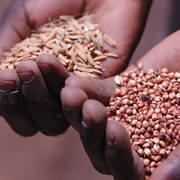2nd Post: Back from the field
04.05.13
Yesterday I returned to Kathmandu after spending the previous days in a locality within Ramechhap district. Commuting to the area 
involves a couple of public buses, an hour long hike and another hour and a half long jeep ride up the dirt roads. It is a hilly area with scattered clusters of a fairly small number of houses. Surrounding each of these houses are their terraced fields, some cultivated and some not.
I and three of the NGO’s Nepali local staff aiding me, focused our efforts mapping a specific subdivision of the district, where the greater part of our study is to take place. Each cluster visited began by locating someone willing and able to answer a short list of questions regarding his village’s characteristics, and ended with me writing down the coordinates of the place using a GPS app I downloaded. Half or so we covered by hiking from one village to the other while the second half by aid of a rented local jeep driver. It was hard catching up with these guys’ pace, who climb up and down that steep terrain like it’s nothing. For me it was something. At the end of the first day once we returned to the local bazaar area where we stayed, and I found myself spontaneously raising my hands in the air as if winning a race; while they were casually walking a few meters ahead of me.
The local community was mostly friendly and welcoming and I enjoyed the company in spite of the fact that I could not understand the conversation held around me a great deal of time (I am slowly picking up words though). At the end of my visit we were invited to the office of a modest local NGO where I was asked to write something in their guestbook and take part in a short ceremony where you bow your head and get a scarf.
 Living conditions are very basic. There is access to drinking water (I kept to bottled), and most villages are able to get to the local bazaar to get supplies or trade within a couple of hours walking distance. There is no electricity, so many of the households use solar power that provides minimal lighting when dark. While varying crops and vegetables are being grown in the area, the scarcity of irrigation sources ends in most of the fields being limited to rainwater irrigation and many plots stay uncultivated. Hopefully the Israeli NGO’s intervention will boost production and crop variety, and following that the well-being of the local farmers.
Living conditions are very basic. There is access to drinking water (I kept to bottled), and most villages are able to get to the local bazaar to get supplies or trade within a couple of hours walking distance. There is no electricity, so many of the households use solar power that provides minimal lighting when dark. While varying crops and vegetables are being grown in the area, the scarcity of irrigation sources ends in most of the fields being limited to rainwater irrigation and many plots stay uncultivated. Hopefully the Israeli NGO’s intervention will boost production and crop variety, and following that the well-being of the local farmers.
To sum up, I believe these few days in the field were important. Data and insights gathered will enable us to finalize the study design, and run our first household survey. I fly home the day after tomorrow.
Yannay




